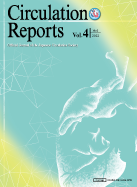4 巻, 6 号
選択された号の論文の8件中1~8を表示しています
- |<
- <
- 1
- >
- >|
Reviews
-
 原稿種別: REVIEW
原稿種別: REVIEW
2022 年 4 巻 6 号 p. 241-247
発行日: 2022/06/10
公開日: 2022/06/10
[早期公開] 公開日: 2022/04/20
Original Articles
Cardiovascular Surgery
-
原稿種別: ORIGINAL ARTICLE
専門分野: Cardiovascular Surgery
2022 年 4 巻 6 号 p. 248-254
発行日: 2022/06/10
公開日: 2022/06/10
[早期公開] 公開日: 2022/04/29PDF形式でダウンロード (449K) HTML形式で全画面表示
Heart Failure
-
原稿種別: ORIGINAL ARTICLE
専門分野: Heart Failure
2022 年 4 巻 6 号 p. 255-263
発行日: 2022/06/10
公開日: 2022/06/10
[早期公開] 公開日: 2022/04/23PDF形式でダウンロード (2139K) HTML形式で全画面表示 -
原稿種別: ORIGINAL ARTICLE
専門分野: Heart Failure
2022 年 4 巻 6 号 p. 264-273
発行日: 2022/06/10
公開日: 2022/06/10
[早期公開] 公開日: 2022/05/25PDF形式でダウンロード (1909K) HTML形式で全画面表示
Valvular Heart Disease
-
原稿種別: ORIGINAL ARTICLE
専門分野: Valvular Heart Disease
2022 年 4 巻 6 号 p. 274-284
発行日: 2022/06/10
公開日: 2022/06/10
[早期公開] 公開日: 2022/04/28PDF形式でダウンロード (3071K) HTML形式で全画面表示
Images in Cardiovascular Medicine
-
原稿種別: IMAGES IN CARDIOVASCULAR MEDICINE
2022 年 4 巻 6 号 p. 285-286
発行日: 2022/06/10
公開日: 2022/06/10
[早期公開] 公開日: 2022/05/18PDF形式でダウンロード (668K) HTML形式で全画面表示 -
原稿種別: IMAGES IN CARDIOVASCULAR MEDICINE
2022 年 4 巻 6 号 p. 287-288
発行日: 2022/06/10
公開日: 2022/06/10
[早期公開] 公開日: 2022/05/26PDF形式でダウンロード (3658K) HTML形式で全画面表示
-
2022 年 4 巻 6 号 p. Content6-
発行日: 2022/06/10
公開日: 2022/06/10
PDF形式でダウンロード (665K)
- |<
- <
- 1
- >
- >|
